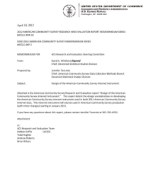
An official website of the United States government
Here’s how you know
Official websites use .gov
A .gov website belongs to an official government organization in the United States.
Secure .gov websites use HTTPS
A lock (
) or https:// means you’ve safely connected to the .gov website. Share sensitive information only on official, secure websites.
-
//
- Census.gov /
- Library /
- Census Working Papers /
- Design of the American Community Survey Internet Instrument
Design of the American Community Survey Internet Instrument
Design of the American Community Survey Internet Instrument
The American Community Survey (ACS) is an on-going survey designed to provide communities with reliable and timely demographic, social, economic and housing data every year. The ACS collects data in every U.S. county and Puerto Rico and has an annual sample of about three million addresses allocated into twelve monthly samples of approximately 250,000 addresses each.
Currently, the ACS collects data using three sequential modes: mail, followed by nonresponse follow-up by telephone and finally personal visit1. The 2011 ACS Internet Test was designed to evaluate the feasibility of introducing a web response mode during the mail data collection phase. The main objective was to determine the best way to present the Internet mode in the mailings to maximize response.
The Census Bureau tested "choice" and "push" strategies for notifying sampled units about the Internet mode. The choice strategy allowed households to choose between mail and web to respond. Under the choice strategy, the Census Bureau tested two approaches â a prominent versus a subtle choice. In the prominent choice, the web option was noticeably advertised in all mailings as an alternative to the mail questionnaire. Under the subtle choice design, the web option appeared only on the questionnaire in an inconspicuous place. The motivation for testing a subtle choice was to combat the potential response decrease that has occurred in previous studies when web is presented a response mode choice (Griffin et al. (2001); Smyth et al. (2010); Gentry et al. (2008); Lesser (2010)), while still providing the option for those who are specifically looking for it.
The push strategy directed households to use the Internet first before offering the paper questionnaire at a later mailing. If they did not respond by Internet after a few weeks, they received a paper questionnaire. While the push strategy has not proved effective in previous studies (Bentley et al., 2006; Brady et al., 2004), it seemed important to retest as it has potential cost savings. If successful in maintaining or increasing response, this strategy may save costs associated with printing, postage, data capture, as well as nonresponse follow-up costs.
Others in Series
Working Paper
Working Paper
Working Paper
Share
Some content on this site is available in several different electronic formats. Some of the files may require a plug-in or additional software to view.
 Yes
Yes
 No
NoComments or suggestions?


Top

